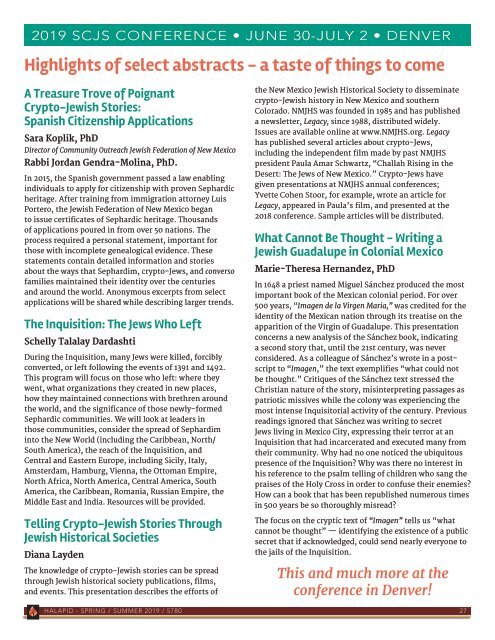HaLapid-Spring Summer 2019
Create successful ePaper yourself
Turn your PDF publications into a flip-book with our unique Google optimized e-Paper software.
<strong>2019</strong> SCJS CONFERENcE • June 30-July 2 • denver<br />
Highlights of select abstracts - a taste of things to come<br />
A Treasure Trove of Poignant<br />
Crypto-Jewish Stories:<br />
Spanish Citizenship Applications<br />
Sara Koplik, PhD<br />
Director of Community Outreach Jewish Federation of New Mexico<br />
Rabbi Jordan Gendra-Molina, PhD.<br />
In 2015, the Spanish government passed a law enabling<br />
individuals to apply for citizenship with proven Sephardic<br />
heritage. After training from immigration attorney Luis<br />
Portero, the Jewish Federation of New Mexico began<br />
to issue certificates of Sephardic heritage. Thousands<br />
of applications poured in from over 50 nations. The<br />
process required a personal statement, important for<br />
those with incomplete genealogical evidence. These<br />
statements contain detailed information and stories<br />
about the ways that Sephardim, crypto-Jews, and converso<br />
families maintained their identity over the centuries<br />
and around the world. Anonymous excerpts from select<br />
applications will be shared while describing larger trends.<br />
The Inquisition: The Jews Who Left<br />
Schelly Talalay Dardashti<br />
During the Inquisition, many Jews were killed, forcibly<br />
converted, or left following the events of 1391 and 1492.<br />
This program will focus on those who left: where they<br />
went, what organizations they created in new places,<br />
how they maintained connections with brethren around<br />
the world, and the significance of those newly-formed<br />
Sephardic communities. We will look at leaders in<br />
those communities, consider the spread of Sephardim<br />
into the New World (including the Caribbean, North/<br />
South America), the reach of the Inquisition, and<br />
Central and Eastern Europe, including Sicily, Italy,<br />
Amsterdam, Hamburg, Vienna, the Ottoman Empire,<br />
North Africa, North America, Central America, South<br />
America, the Caribbean, Romania, Russian Empire, the<br />
Middle East and India. Resources will be provided.<br />
Telling Crypto-Jewish Stories Through<br />
Jewish Historical Societies<br />
Diana Layden<br />
The knowledge of crypto-Jewish stories can be spread<br />
through Jewish historical society publications, films,<br />
and events. This presentation describes the efforts of<br />
the New Mexico Jewish Historical Society to disseminate<br />
crypto-Jewish history in New Mexico and southern<br />
Colorado. NMJHS was founded in 1985 and has published<br />
a newsletter, Legacy, since 1988, distributed widely.<br />
Issues are available online at www.NMJHS.org. Legacy<br />
has published several articles about crypto-Jews,<br />
including the independent film made by past NMJHS<br />
president Paula Amar Schwartz, “Challah Rising in the<br />
Desert: The Jews of New Mexico.” Crypto-Jews have<br />
given presentations at NMJHS annual conferences;<br />
Yvette Cohen Stoor, for example, wrote an article for<br />
Legacy, appeared in Paula’s film, and presented at the<br />
2018 conference. Sample articles will be distributed.<br />
What Cannot Be Thought - Writing a<br />
Jewish Guadalupe in Colonial Mexico<br />
Marie-Theresa Hernandez, PhD<br />
In 1648 a priest named Miguel Sánchez produced the most<br />
important book of the Mexican colonial period. For over<br />
500 years, “Imagen de la Virgen Maria,” was credited for the<br />
identity of the Mexican nation through its treatise on the<br />
apparition of the Virgin of Guadalupe. This presentation<br />
concerns a new analysis of the Sánchez book, indicating<br />
a second story that, until the 21st century, was never<br />
considered. As a colleague of Sánchez’s wrote in a postscript<br />
to “Imagen,” the text exemplifies “what could not<br />
be thought.” Critiques of the Sánchez text stressed the<br />
Christian nature of the story, misinterpreting passages as<br />
patriotic missives while the colony was experiencing the<br />
most intense Inquisitorial activity of the century. Previous<br />
readings ignored that Sánchez was writing to secret<br />
Jews living in Mexico City, expressing their terror at an<br />
Inquisition that had incarcerated and executed many from<br />
their community. Why had no one noticed the ubiquitous<br />
presence of the Inquisition? Why was there no interest in<br />
his reference to the psalm telling of children who sang the<br />
praises of the Holy Cross in order to confuse their enemies?<br />
How can a book that has been republished numerous times<br />
in 500 years be so thoroughly misread?<br />
The focus on the cryptic text of “Imagen” tells us “what<br />
cannot be thought” — identifying the existence of a public<br />
secret that if acknowledged, could send nearly everyone to<br />
the jails of the Inquisition.<br />
This and much more at the<br />
conference in Denver!<br />
<strong>HaLapid</strong> - SPRING / SUMMER <strong>2019</strong> / 5780 27



